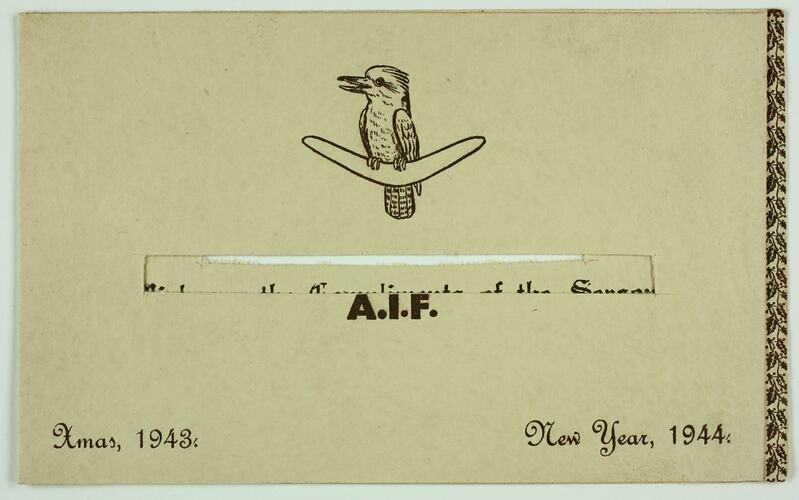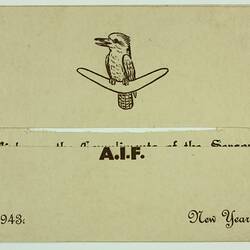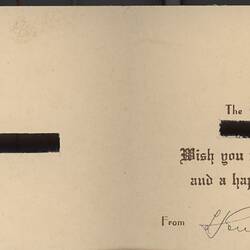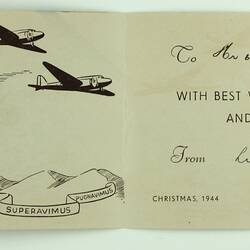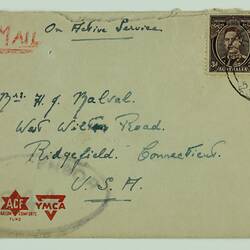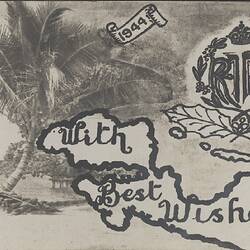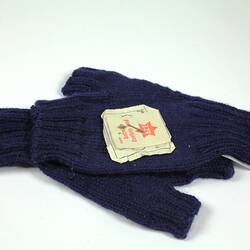Summary
Christmas and New Year greeting card signed by Captain Leo James Pollard of the 2/10 Australian Infantry Battalion, presumably to Margaret Malval, dated 1943-1944. This card was sent as part of regular correspondence between Margaret and Leo. It is a standard card with a kookaburra on a boomerang motif on the front, printed by the A.I.F and the infantry details have been cut out by the censors.
Margaret Malval emigrated to the United States of America from Melbourne, Australia in 1935. During World War II she volunteered for the American Women's Voluntary Services and sent packages to Australian soldiers through the Australian Comforts Fund, thereby entering into an exchange of correspondence with a number of Australian soldiers based in the Pacific and in Australia.
Physical Description
Cream coloured card with central fold, with kookaburra on a boomerang motif printed in brown ink on the front. Also printed on the front A.I.F/Xmas, 1943/New Year, 1944. Narrow border of brown printed holly along one edge. Inside the card contains a seasons greetings message. The card has a central slot cut out where the infantry battalion details were printed.
Significance
This collection of letters and cards are significant as they illustrate the continuing ties felt by an emigrant to their country of birth. Margaret Malval was born and grew up in Melbourne, Victoria and moved to the United States of America to be married in 1935, where she lived for the rest of her life. Though her husband served in the United States Armed Forces, Margaret chose to send care packages to Australian soldiers through the Australian Comforts Fund, suggesting she retained strong ties to Australia.
These letters and cards were sent from Australian servicemen to Margaret, initially after receiving a care package from her which she donated through the Australian Comforts Fund. These letters and cards highlight the support of people on the home front for Australian servicemen by sending care packages through organisations like the Australian Comforts Fund, and the response of Australian Servicemen on receipt of these packages. Additionally, this collection also helps tell the stories of the frontline experience of Australian servicemen during World War II.
More Information
-
Collecting Areas
-
Acquisition Information
Donation from Ms Jeanne Cook, 05 Nov 2009
-
Sender
-
Addressed To
-
Inscriptions
Front: 'A.I.F. / Xmas, 1943 New Year, 1944' Inside: 'OFFICERS MESS / The Officers, N.C.O's & Men of the__Wish you the Compliments of the Season and a happy conclusion to it all in 1944 / From [signed] L Pollard'
-
Classification
-
Category
-
Discipline
-
Type of item
-
Overall Dimensions - Closed
135 mm (Width), 85 mm (Height)
-
Keywords
Australians at War, Correspondence, Military Communication, Military History, War Effort, War Service, Wars & Conflicts, World War II, 1939-1945, Military Censorship, Soldiers' Comforts
